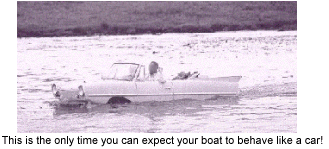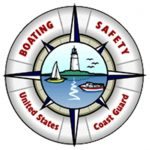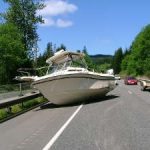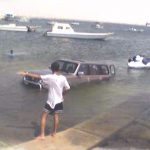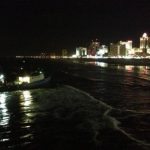In most places in the United States today, the only thing you need to operate a powerboat is a checkbook or decent line of credit. Mr. Newboater leaves the dealer with Proud Mary in tow, confidently believing that if he knows how to drive that tow vehicle, he’ll know how to drive that boat. He’s about to find out just how wrong he is.
Licensing
In all but a few states, there is no licensing requirement for operating a boat. And that means any boat, from a jonboat with a 5-horsepower outboard to a three-engine, 1,000-horsepower or more offshore cigarette boat. But we all know that the simple act of issuing a license is not going to contribute one iota to the safety of anyone on or near the water. Where there is licensing or certification, however, there is usually a requirement to prove at least a fundamental knowledge of the rules. To drive a car, you have to show you know what an eight-sided sign means and how far you have to park from a fire hydrant. To drive a boat, you should have to know what a pointy-topped buoy means and how far you have to stay away from another boat. But you don’t in most states, and therefore Mr. Newboater needs to know that he’ll be out on the water with other unlicensed drivers. How would he like to face that on the freeway every morning?
Steering
Once on the water with his new acquisition, Mr. Newboater soon will learn, we hope, that his boat doesn’t steer the way his car does. He should notice that when he turns the wheel, the back doesn’t follow the front. It swings out to the side, with the boat pivoting on a point about a third of the way back. And when he backs, a similar phenomenon occurs, only this time the bow (sorry, front) swings in a fairly wide arc. And, if Mr. Newboater’s new craft happens to be of a “personal” variety, as in “personal watercraft,” he’ll find that he has no steering at all at very slow speeds, or if the engine is shut off or quits.
Braking
If Mr. Newboater is like some boaters I’ve observed, he will compensate for the fact that the boat doesn’t have a brake pedal by substituting the utility of his reverse gear. Approaching a dock too fast, he’ll ram the throttle lever in reverse. Too often, this maneuver will reduce his control of the boat, and he’ll find himself looking the part of an inexperienced boater, at best.
Lighting
Cars operate at night by illumination. The headlights seek out obstructions in the road ahead, and you follow the lines. Since there aren’t any lines on the water to follow, and since boats are allowed pretty much to “wander” along the surface, unconstrained by ditches and fenceposts, boats don’t use headlights. Recognition of hazards on the water is accomplished through lighting patterns, which the vessel operator must be able to interpret. A white and red light indicate that there likely is another boat within sight of you, and he is in your danger zone, and you need to give way if he’s crossing. A red, green and white light should indicate that you’re meeting another vessel head-on, and appropriate action needs to be taken. Without knowing what those patterns mean, Mr. Newboater is going to be pretty confused the first time he takes Proud Mary out at night.
Seating
Unless Mr. Newboater has a huge motorhome, he’s probably used to his passengers sitting, buckled up in their seatbelts and not wandering around the inside of his car or truck while its tooling down the highway. All the seats in his car probably sit facing forward. If he drives a convertible, it’s probably got a slick, shiny hood and room on top of the doors to sit. But I’ll venture to say that he’s never let anyone sit on them. Boat manufacturers put seats in boats, too, but they also put gunwales on boats. “Gunnels” are the flat places along the edge of the boat where kids sit illegally, get thrown out of the boat, and if they’re lucky, miss the propeller and get retrieved.
Mr. Newboater will have to get used to the idea that when he brings the throttle back quickly from wide-open to neutral, some of his passengers are going to fly headlong from the back seat to the cutty cabin, and if he goes quickly from neutral to wide-open, some of them are going in the drink over the stern. And further, if he makes a tight turn at a high speed, he’s going to throw the ones sitting on the outboard gunwale overboard. After a time, he probably will tell everybody to sit in the seats that were designed for that purpose, and will loudly announce when he is going to adjust his speed or direction. But until he gains that experience, he and his passengers may be in for some real hairy times.
There are lots of other differences between driving a car and driving a boat that Mr. Newboater will have to experience?like operating in three dimensions instead of two and language and nomenclature. He can gain that knowledge quickly, by taking a boater safety course or two, thus minimizing the risk to himself and his passengers of serious injury or worse. Or he can adhere to the old maxim, “Good decisions come from experience…experience comes from bad decisions,” and simply carry his ignorance and bad habits forward from season to season.
It’s true. A car and a boat both move you from one place to another. But with experience comes the realization that any other similarities are purely coincidental.

